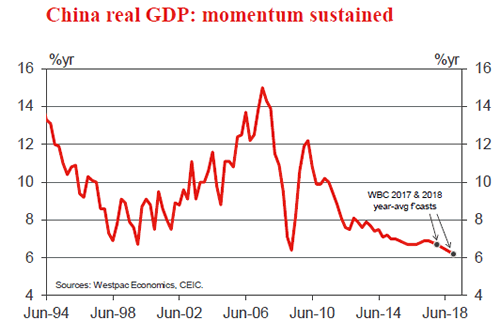Week beginning 16 October 2017
- The dark side of the lift in Consumer Sentiment.
- RBA: RBA minutes, Assistant Governors Ellis & Bullock speak.
- Australia: employment, Westpac-MI Leading Index.
- NZ: CPI.
- China: 19th National Congress, PBoC Governor Zhou speaks, GDP, CPI.
- Euro Area: European Council, ECB President Draghi speaks.
- US: Fed Chair Yellen speaks, housing starts & permits, existing home sales.
- Key economic & financial forecasts.
Information contained in this report was current as at 13 October 2017.
The Dark Side of the Lift in Consumer Sentiment
This week we saw a strong lift in the Consumer Sentiment Index.
The Westpac Melbourne Institute Index of Consumer Sentiment rose 3.6% to 101.4 in October from 97.9 in September.
It is the first time since November last year that optimists have outnumbered pessimists and represents the highest level of the Index since October last year.
Consistent reports of an improving global economy may have been a factor behind this lift in confidence. It is also likely that concerns about rising interest rates associated with over-heated housing markets have eased.
Ongoing improvements in the labour market are also boosting confidence. Confidence showed stronger gains amongst those employed as tradies, ‘paraprofessionals’ (typically in the health and education sectors), or labourers. The rise in confidence was particularly strong for ‘trade’ workers, up 22% in the month, suggesting the continued strength in residential building was a positive factor.
This is not a great surprise. The recent report from the ABS shows that of the net 320,000 jobs added over the year to August nearly a third (105,000) were added in the construction sector. We expect this will be about as good as it gets for construction workers. The downturn in residential construction activity is expected to bite through 2018.
Overall, confidence is still not particularly strong, with views on family finances a clear weak spot. Whereas the overall Index is down 1% on a year ago, respondents’ assessments of their own finances relative to a year ago have fallen by 6.1%.
This is a particularly significant point. Recall that the Reserve Bank consistently refers to this component of the Index as a reliable indicator of spending patterns.
The logic is persuasive. Consumers are more likely to base their spending decisions on their current income capacity rather than necessarily expectations around the overall economic outlook where they may not necessarily be a beneficiary.
During the week I noticed reports that US consumers are particularly pessimistic about: living from ‘paycheck’ to ‘paycheck’; never being able to get out of debt; and never being able to afford to retire. Fortunately, Australia’s pension and superannuation system provides households with much more comfort around the retirement issue but I suspect Australians would be similarly concerned about the first two issues.
That 6.1% fall over the year in "finances relative to a year ago" is quite significant. In previous years (to October) the comparable movements have been: -2.4% (2016); 4.3% (2015); flat (2014); 6.2% (2013); 1.2% (2012); -12.9% (2011); flat (2010); 21% (2009); -24% (2008).
The big fall in 2011 was associated with the 200 basis points of mortgage rate increases from October 2009 while the fall in 2008 was in response to the collapse of Lehman and the onset of the GFC. The fall in 2017 is therefore by far the largest annual fall in this component outside unusual extraordinary events since the GFC. This move is likely to be associated with some of the factors that are most likely behind the reports from the US: weak wages growth and excessive levels of household debt. It is for these reasons that we are cautious about prospects for consumer spending and, although the overall Index lifted strongly, the concerns about the consumer must still remain. It is certainly true that other parts (with the exception of housing) were solid in the survey.
The ‘economic conditions, next 12 months’ sub-index posted the strongest gain, rising 7.1% to a four year high. Some of this likely stems from consistent coverage of the continuing improvement in the global economy with, in particular, improved confidence in the US growth outlook. Longer term economic prospects showed a more muted rise. The ‘economic outlook over the next 5 years’ sub-index rose just 1.4%.
Consumers were more positive about making major purchases, the ‘time to buy a major household item’ sub-index rose 3.5% in October after a 2.1% lift in September. However, the sub-index remains well below its long run average (down 2.9% over the year), suggesting that the sluggish spending evident through most of 2017 is likely to extend into year-end.
Expectations for the labour market continue to improve. The Westpac Melbourne Institute Unemployment Expectations Index fell 3.3% to 129.2 in October, marking the lowest reading since June 2011 (recall that lower reads mean more consumers expect unemployment to fall in the year ahead). The move is broadly based with expectations improving across all the major states. So, as in the US survey, households may be becoming less anxious about actually losing their jobs but concerned about the size of that ‘paycheck’.
Consumer views around housing remained downbeat. The ‘time to buy a dwelling’ index dipped 0.2% to 95.1, well below the long run average of 120. State indexes continue to vary widely, ranging from very weak reads in NSW (77) and Vic (88) to a strongly positive result in WA (135.4).
Consumer expectations for house prices also softened in the month. The Westpac-Melbourne Institute Index of House Price Expectations dipped 1% to 140.5. The index still shows positive price expectations nationally although the state breakdown showed a sharp 8% decline in New South Wales (to the lowest level since June last year) partially offset by stronger price expectations in Queensland and Western Australia. Evidence that house price expectations in the over-heated Sydney market are cooling is likely to be encouraging for policymakers.
We contend that the key to the interest rate outlook remains the consumer and the housing market. While we have seen a boost in consumer confidence, most of the strength is centred on the one year economic outlook. Respondents remain concerned about their own finances despite an expectation that the economy overall will improve.
Furthermore, the survey continues to point to an easing in sentiment in the housing markets in the major states. Interest rate increases aimed at cooling over-heated housing markets appear to be becoming unnecessary as macro prudential policy tools and the slowdown in foreign activity are achieving the same purpose.
The Week that Was
This week saw the release of our October Market Outlook. In addition to our latest assessment of conditions in Australia; New Zealand; the global economy and FX markets, key themes investigated this month include: Australian employment trends by industry and state, highlighting the narrow focus of job creation; the housing sector’s loss of momentum, focusing on the role played by policy and foreign buyers; and the construction sector, where the balance between mining, non-mining and residential investment activity is shifting. Overseas, ahead of it beginning on 18 October, we look forward to the 19th National Congress in China.
On the data front, sentiment was the focus in Australia this week. We also received an update on housing finance and, from the RBA, the latest Financial Stability Review.
The Westpac-MI Consumer Sentiment survey provided a very interesting update this month. The headline index rose 3.6% to 101.4, the first outcome above the 100 optimist/pessimist divide since November last year. Economic expectations for the coming year jumped 7% and the 5-year view also improved. Unsurprisingly, unemployment expectations fell further, posting their lowest read since June 2011 as consumers became more optimistic over job prospects. However, despite all of the above and an abating of concern over recent interest rate increases, family finance expectations are still circa 5pts below their longrun average level, both relative to a year ago and for the year ahead. This is also true of the ‘time to buy a major household item’ series, implying that growth in retail spending is likely to remain subdued irrespective of the lift in overall confidence. On housing, house price expectations remain elevated versus history, but ‘time to buy a dwelling’ is holding some 25pts below average. By state, the ‘cost’ of affordability is clearly evident, with very weak results reported for NSW and Vic.
Also, housing finance data came in a little above expectations in August. Investor finance continued to hold up despite the impact of macro-prudential measures, likely in part because of refinancing activity. The investor result also likely signals that the recent loss of momentum in capital city markets (particularly Sydney) has come as a result of a pullback by foreign buyers. Lending for purchases of newly built dwellings continue to show strength (23%yr) as more buildings are completed and made available for occupancy. First home buyer approvals have also continued to strengthen, up 40%yr.
On the business sector, the September NAB business survey was positive overall; however, a concern for the outlook is that conditions are uneven across the economy. The sectors that are supporting conditions at above average levels are construction and related industries, including manufacturing. Elsewhere, weakness is clearly evident, particularly in the retail sector which is being affected by: weak wages; household debt; rising energy costs; housing affordability and the peak in housing investment activity. These results fit with our concerns regarding the outlook. We anticipate that consumption growth will struggle to accelerate as housing investment turns down. That will restrict 2018 growth to a below trend outcome. A positive for the interim is that the employment index from the NAB survey suggests the current strong pace of employment growth will be sustained through year end.
From the RBA, as is typically the case, there were no surprises in the October Financial Stability Review. Excessive risk taking globally supported by historically low interest rates was cited as a key global risk, as was debt in China. Meanwhile for Australia, "household balance sheets and the housing market remain a core area of interest". On this front, it was emphasised that policy actions have brought greater resilience to the sector. The overall health of the financial sector and the Australian economy was regarded as strong. Worthy of a read are the special topic boxes on: risks in international housing markets; and Australian households’ investment property exposures.
Offshore this week, it was relatively quiet. The FOMC September meeting minutes franked expectations of a December rate hike, but also clearly emphasised that the Committee is uneasy over the inflation outlook. This is a topic we cover in depth in the October Market Outlook. The take home is that, while the structural health of the economy has improved materially, slack remains in the labour market. Further context on this labour market slack was provided this week in Northern Exposure. In short, while hiring and job openings are elevated, so too is churn in and out of the labour market. In combination with historically weak participation of prime-aged workers, this trend implies that many US workers are struggling to find permanent employment and thus the household income they desire. This is likely to keep a lid on wage pressures and see consumer price inflation remain a little below the FOMC’s 2.0%yr medium-term target. We remain confident in our view that the FOMC will only hike twice more in this cycle following the December 2017 decision – likely in June and December 2018.
Chart of the week: Job creation & losses year to Aug 2017
In the edition of our October Market Outlook, we provide an update on Australian employment trends by industry and by state. Total annual employment growth has accelerated to a well above trend 2.75%. Interestingly, the hiring surge has been narrowly focused with household services the key driver, followed by construction. The current relatively narrow job upswing contrasts with the broad based strength evident in 2015/16 and is symptomatic of the broader uneven economic expansion.
Through the last year the net balance of sectors expanding vs. those contracting was +1, highlighting just how narrow the current expansion is. Compare that to the 2015/2016 peak in employment growth of 3%yr when the net balance was +4 and it held this level for a year.
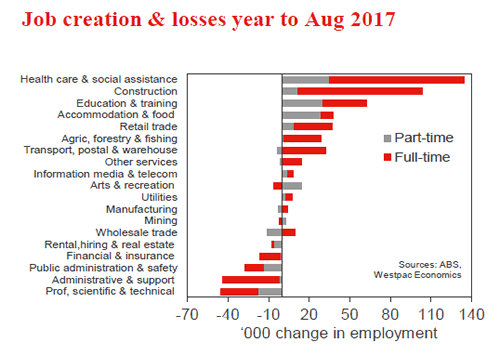
New Zealand: Week ahead & Data Wrap
Signs of life
There is growing evidence that the slowdown in the housing market over the last year is weighing on household spending decisions. We wouldn’t be surprised to see a brief revival in house prices over the next few months. But the outlook for the next couple of years remains subdued, in the absence of a substantial fall in interest rates.
Retail spending on debit and credit cards rose just 0.1% in September, less than we and the market expected. That continued a string on several months where card spending has been flat or even lower. A fall in petrol prices over this year could explain some of the slowdown in spending, but there’s little sign that households are taking advantage of their fuel savings to spend more elsewhere. Spending on clothing and durable goods has flatlined, and the rise in hospitality spending (which includes international tourists) has slowed.
Consumer spending in New Zealand tends to have a strong link with the housing market, reflecting the fact that housing makes up a very high proportion of household wealth. The slowdown in spending in recent months is consistent with the cooling in house prices over the last year. Prices are down slightly from their peaks in Auckland and Christchurch, and are rising at a slower pace than before in other regions.
We believe the rise in mortgage rates over the last year has been a significant factor in the housing slowdown. Over much of 2015 and 2016, fixed-term mortgage rates were steadily declining, which incrementally added more fuel to the housing market. But from late 2016, mortgage rates ceased falling and began to rise – not by huge amounts, but the change of direction was enough to take the heat out of the housing market.
The latest round of restrictions on loan-to-value ratios, which were targeted at property investors, are also likely to have been a factor in the early stage of the slowdown. But the experience both here and overseas suggests that the impact of lending restrictions is short-lived; the current slowdown has lasted for longer than could be explained by LVR restrictions alone. Caution ahead of the 23 September election may also have been a factor, to the extent that investors feared the possible introduction of a capital gains tax for investment properties.
A key question for the economic outlook is whether the slowdown in house prices will persist. We wouldn’t be surprised to see a brief rebound in house prices over the next few months. The most recent moves in mortgage rates have been down – again, not by a large amount, but the change of direction is notable. The banking system is now striking a better balance between deposits and loans than it was a year ago, reducing the pressure for banks to lift lending and deposit rates.
The election uncertainty factor remains, as the coalition talks between the main parties drag on. (The latest indication is that a decision could be announced as late as the end of next week.) But the NZ First Party, which is being courted by both the National and Labour Parties, does not favour a capital gains tax, so that policy is unlikely to make it into the mix when the next Government is formed.
There have in fact been some tentative signs of life in house prices already. The REINZ house price index rose 1% in September, the second monthly increase in a row. The stabilisation in prices has been supported by a sharp drop in new listings in recent months – property owners don’t sell into a falling market if they don’t have to. As a result, the stock of unsold homes has actually started falling again, which has alleviated the downward pressure on prices. However, housing turnover remains very subdued, with the number of sales falling to a six-year low. That doesn’t augur well for a sustained lift in prices.
Unless the Reserve Bank reduces the OCR, there is a limit to how far mortgage rates can fall in the short run. Over a longer timeframe we would expect fixed mortgage rates to rise in anticipation of OCR hikes and in response to rising global interest rates. Consequently, beyond a short-term fillip, we expect house prices to remain subdued in coming years. And consequently, we would expect consumer spending growth to be more subdued than it has been in previous years – more in line with the pace of income growth.
A slowdown in spending growth in turn implies that there is even less risk of the economy overheating. Inflation has picked up from its lows over the last two years – we expect next Tuesday’s CPI release to show inflation close to the Reserve Banks’ 2% target midpoint in the September quarter. But with growth expected to be subdued from here, inflation is unlikely to threaten the top end of the inflation target. And that means the Official Cash Rate can remain low for a long time.
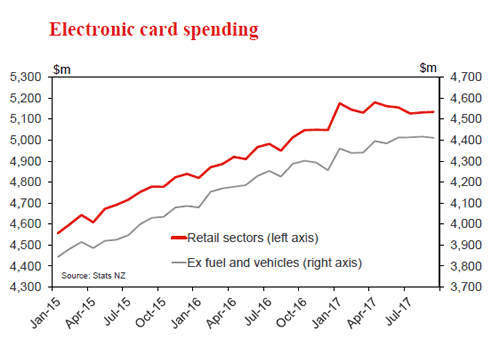
Data Previews
Aus Sep Westpac-MI Leading Index
Oct 18, Last: -0.19%
- The Leading Index has swung sharply in recent months from well above trend to back below trend, the six month annualised growth rate holding at 0.19% below trend in August. The turnaround mainly reflects swings in Australia’s commodity prices and to a lesser extent a shift to a rising yield curve implying tightening financial conditions.
- The Sep read will again see a mixed bag of updates: the ASX200 down -0.6% vs -0.1% last month, US industrial production contracting 0.9% vs a 0.4% gain last month, and commodity prices holding flat in AUD terms but consumer sentiment and consumer unemployment expectations showing solid improvements, dwelling approvals up 0.4% vs -1.2% last month, and the yield spread widening slightly.
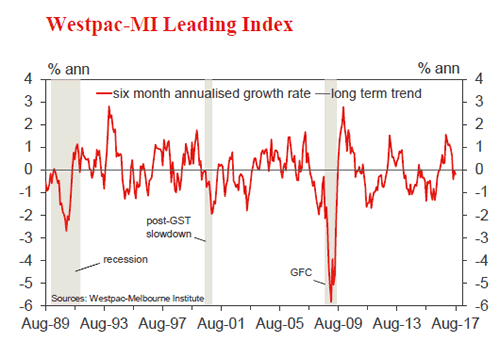
Aus Sep Labour Force, employment ‘000
Oct 19, Last: 54.2k WBC f/c: 25k
Mkt f/c: 15k, Range: -10k to 32k
- Total employment rose 54.2k in August compared the market’s for +20k. Full-time employment bounced 54.2k following a -19.9k correction in Jul. In the year fulltime employment has gained 251.2k/3.0%yr. Part-time employment rose 14.1k following a 49.1k bounce in Jul. In the year to Aug, part-time employment lifted 74.5k/2.0%yr.
- By state, NSW, Vic and Qld were driving the strength with total employment gaining 12.9k, 18.6k and 16.7k respectively.
- The leading indicator including our preferred Jobs Index all point to ongoing robust demand for labour. We are also looking for annual growth in employment to overshoot the Index through late 2017 and into early 2018 as it rebounds from an undershoot during late 2016 early 2017.
- Our forecast 25k rise in employment will lift the annual rate to 3.1%yr from 2.7%yr.
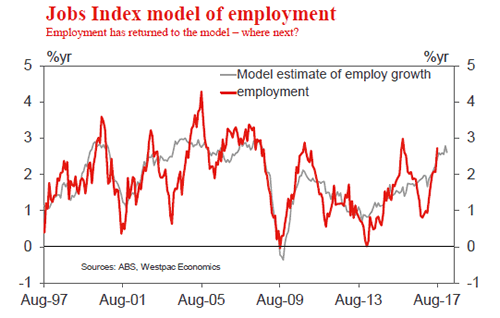
Aus Sep Labour Force, unemployment %
Oct 19, Last: 5.6% WBC f/c: 5.6%
Mkt f/c: 5.6%, Range: 5.4% to 5.7%
- Despite the strong gain in employment, the Aug release printed a flat unemployment rate of 5.6% (5.60% at two decimal places) due to a 0.2ppt gain in the participation rate driving a solid rise the labour force.
- In Aug, the gain in participation came from a lift in both male and female participation but the gains from females have been somewhat greater and females do appear to be on a more solid uptrend. Males, by contrast, look more like they have found some stability in participation. By state, the strongest gains in female participation were in Qld but they are also improving in NSW while Vic continues to hold a very high level of female participation.
- In Sep, we are looking for a flat participation rate of 65.3% which will generate a 30.5k gain in the labour force which, with rounding, will leave the unemployment rate at 5.6%.
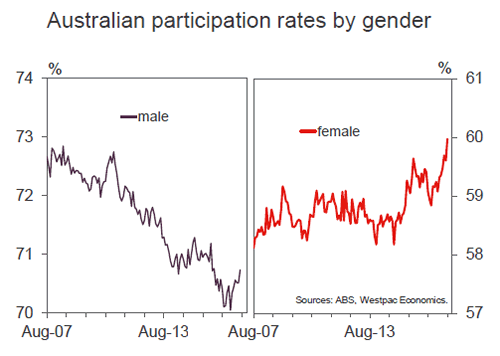
NZ Q3 CPI
Oct 17, Last: 0.0%, Westpac f/c: 0.5%, Mkt f/c: 0.5%
- We expect a 0.5% rise in the Consumer Price Index for the September quarter, lifting the annual inflation rate to 1.9%.
- Food prices rose for the quarter, while fuel prices fell. The strong New Zealand dollar was a disinflationary force over the first half of this year, but we expect its influence to have waned in the September quarter.
- We expect inflation to exceed the Reserve Bank’s forecast for the quarter. However, with economic growth and house prices falling short of the RBNZ’s forecasts, we think that interest rates will need to remain low for even longer than the market expects.
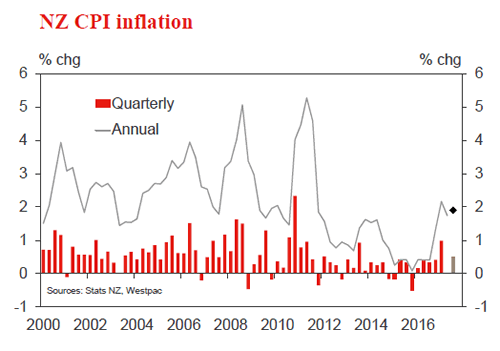
China Q3 GDP
Oct 19, last 6.9%, WBC 6.8%
- In the June quarter, Chinese GDP recorded a third consecutive upside surprise, with annual growth of 6.9%. Versus authorities’ 2017 target of "around 6.5%yr", the six months to June was certainly a strong start.
- Come the September quarter, this momentum has endured. The PMIs continue to report robust momentum across both the manufacturing and services sector, with broad-based support from domestic and external demand.
- Looking forward, the key downside risk to growth is that subdued employment growth caps momentum in household spending. In the near term, it is unlikely to be significant. However, should household incomes not grow in a robust fashion, it could become a bigger cause for concern. In 2018, investment is also likely to be providing less support.
